Addressing Resource Inequities: Examining Under-Resourced Zip Codes in Bexar County
Examining resource inequities in under-resourced Bexar County zip codes reveals disparities in essential resources. We can uplift these communities for equitable development with a holistic approach and strategic partnerships.
Examining Under-Resourced Zip Codes in Bexar County
Bexar County distinguishes itself based on areas with under-resourced San Antonio zip codes that face unique challenges. These zip codes, characterized by vulnerabilities and limited access to necessary resources, require a closer examination to understand the adverse effects of inadequate public, private, and foundation investment. By zooming in on specific zip codes within Bexar County, we can better understand how inequities perpetuate the lack of access to essential services, such as food, healthcare, and banking.
In these under-resourced zip codes, the absence of food, pharmacy, hospital, grocery store, and bank services creates what is known as "deserts" – areas where the necessary resources are scarce or non-existent. Food deserts deprive residents of access to fresh and nutritious food, leading to health disparities and hindering children's cognitive development. The lack of nearby pharmacies and hospitals further compromises residents' well-being as medical services become distant and inaccessible. Moreover, the absence of banks perpetuates financial hardships and limits economic growth opportunities for individuals and businesses, exacerbating the challenges these communities face.
Moving forward, a holistic approach involving public-private partnerships becomes essential to properly resource every zip code in Bexar County, specifically in San Antonio. By leveraging the collective efforts of government entities, educational institutions, community organizations, and businesses, we can develop actionable strategies to allocate adequate funding and bring essential resources to the under-resourced areas. This targeted approach will improve educational outcomes and enhance the quality of life for all residents, ensuring that every zip code in Bexar County thrives and prospers.
Resource Vulnerability Index (RVI) Analysis for Bexar County, TX
We are analyzing the number of banks, pharmacies, hospitals, grocery stores, and recreational facilities in various zip codes within Bexar County, TX. These entities were weighted as follows: Banks (10%), Pharmacies (20%), Hospitals (30%), Grocery Stores (25%), and Recreational Facilities (15%).
Overview of RVI calculation
Each resource's quantity in a zip code is multiplied by its corresponding weightage, and the results are added together to form the RVI for that zip code. A higher RVI indicates better availability and accessibility of essential resources.
The chart below shows the RVIs for each zip code, facilitating comparison and highlighting resource vulnerability in each area.
Bexar Data Analysis
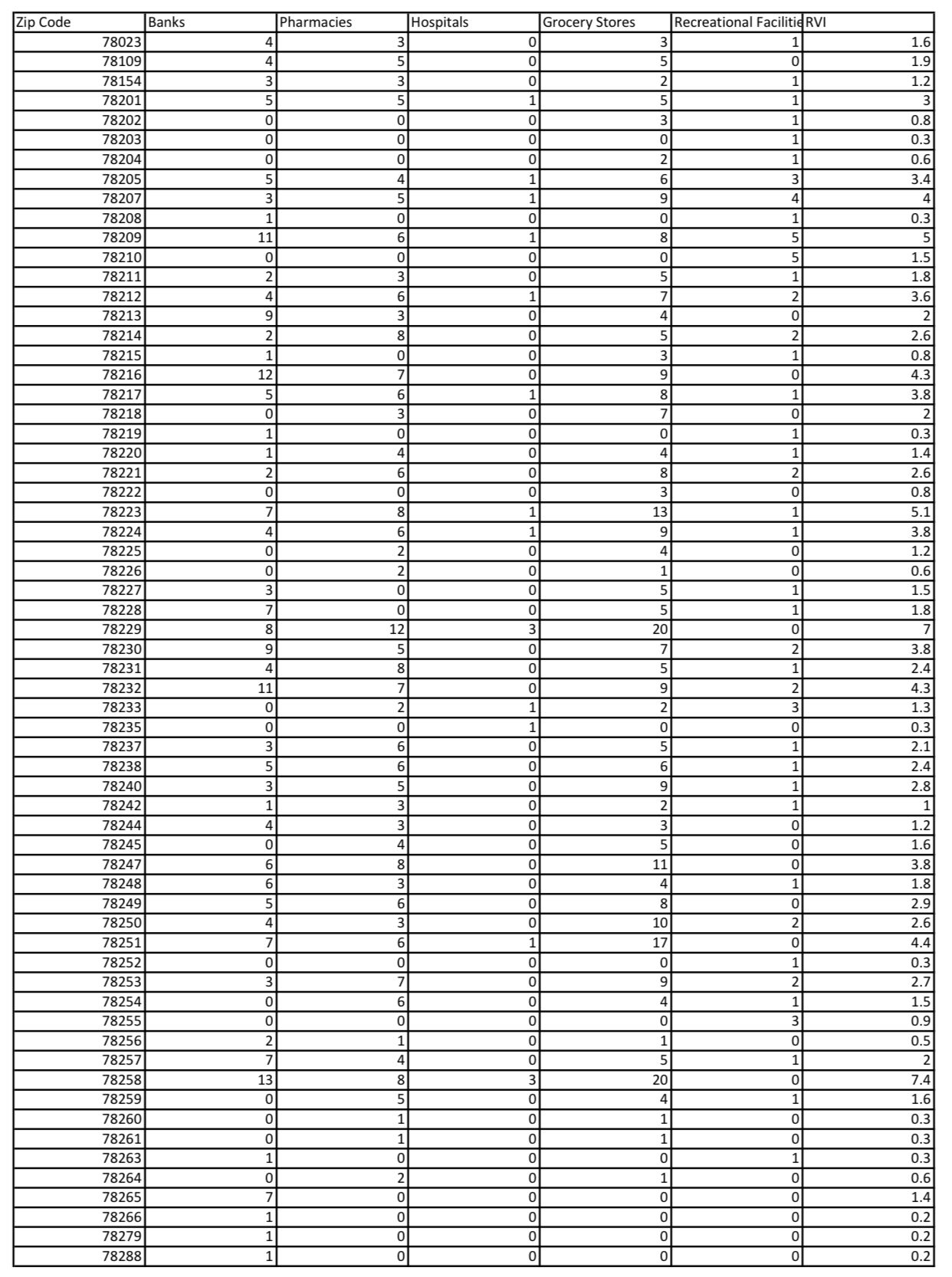
Bexar County Resource Vulnerability Map
The Resource Vulnerability Index (RVI) provides a powerful tool to measure and analyze the availability and accessibility of essential resources within a given geographical area. By assigning weight to categories such as banks, pharmacies, hospitals, grocery stores, and recreational facilities, the RVI can highlight disparities in resource allocation and assist in identifying areas most in need of infrastructure development or resource investment.
The RVI is constructed through a weighted sum of resources available in a given area, and the resulting score represents the area's overall resource vulnerability. Higher scores signify a greater abundance of essential resources and, thus, a lower resource vulnerability. Conversely, lower scores indicate limited access to critical resources, indicating a higher level of vulnerability.
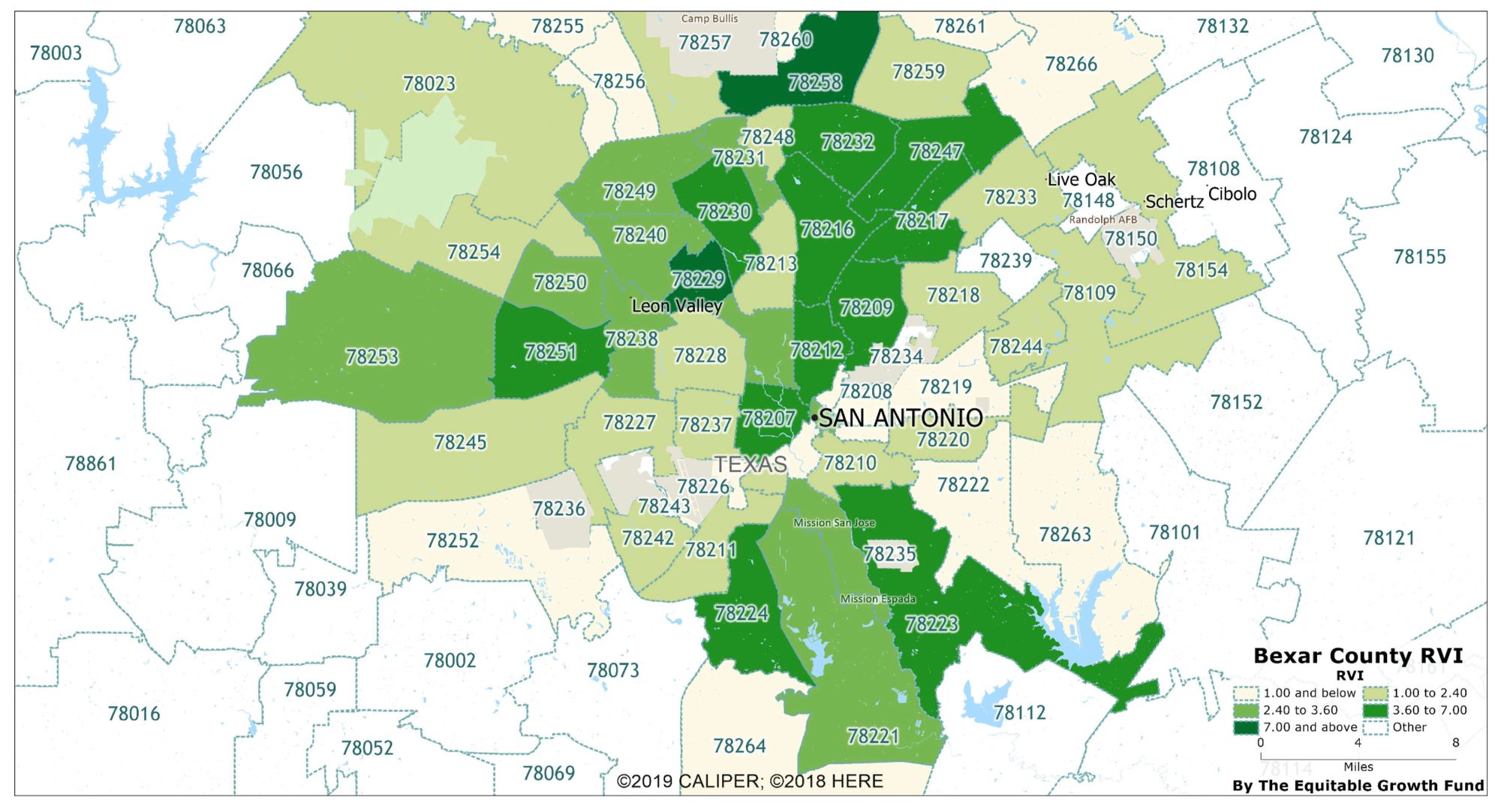
The RVI for each zip code in Bexar County, TX, has been calculated using the abovementioned weights. Notably, the RVI analysis demonstrates a significant variation in the availability of essential resources across the county.
High Resource Areas: Zip codes 78258 and 78229 consistently report the highest availability in most categories, signifying a lower resource vulnerability. For example, zip code 78258 has many banks and grocery stores, while 78229 reports the highest number of pharmacies and grocery stores.
Low Resource Areas: Conversely, several zip codes, such as 78202, 78203, 78204, 78210, and 78235, among others, demonstrate a high resource vulnerability. These areas are particularly underserved regarding banks, pharmacies, and grocery stores. Most notably, almost all areas in the county are underserved in terms of hospitals.
It's crucial to note that the RVI is a dynamic measure and will be updated regularly as more recent data become available. This ensures the RVI's ongoing relevance and efficacy, allowing for timely interventions in areas identified as resource-vulnerable. Doing so makes it possible to guide the allocation of resources better and inform strategies for improvement in the identified areas.
Bexar County Bank Analysis
Access to banks is integral to promoting financial health and fostering economic development within a community. Banks offer essential financial services, including secure savings accounts, credit facilities, loan products, and financial advice. These services empower individuals to manage their finances effectively, plan for future expenses, and invest in educational opportunities, home ownership, or small business development. Moreover, banks play a key role in stimulating local economies by providing business loans and supporting local investments. Therefore, the presence and accessibility of banks can significantly contribute to a community's overall economic well-being and growth.
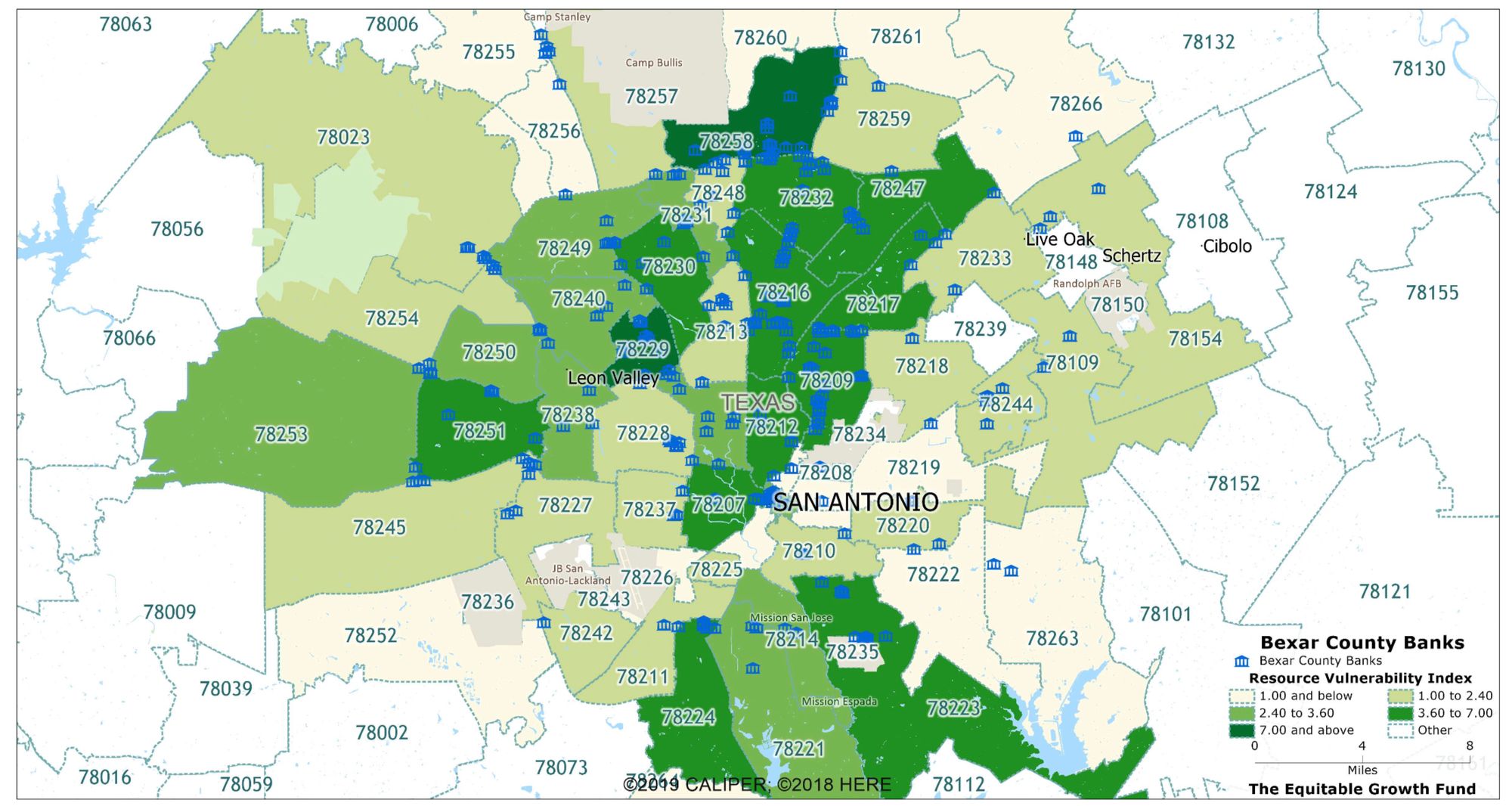
- High Bank Concentration: Notably, 78258 and 78216 are the most financially accessible areas in terms of banking, boasting 13 and 12 banks, respectively. This high concentration of banks potentially indicates a more affluent area where residents have various financial resources.
- Low Bank Concentration: In stark contrast, there are several zip codes with no reported banks: 78202, 78203, 78204, 78210, 78222, 78252, 78255, 78260, 78261, 78265, 78266, 78279, and 78288. This lack of financial institutions can severely limit the residents' ability to access financial services, including savings, credit, and investment opportunities. This can lead to economic instability and potentially perpetuate cycles of poverty in these areas.
Bexar County Pharmacy Analysis
Access to pharmacies is crucial for maintaining community health, as they provide prescription and over-the-counter medication and other health-related products and advice.
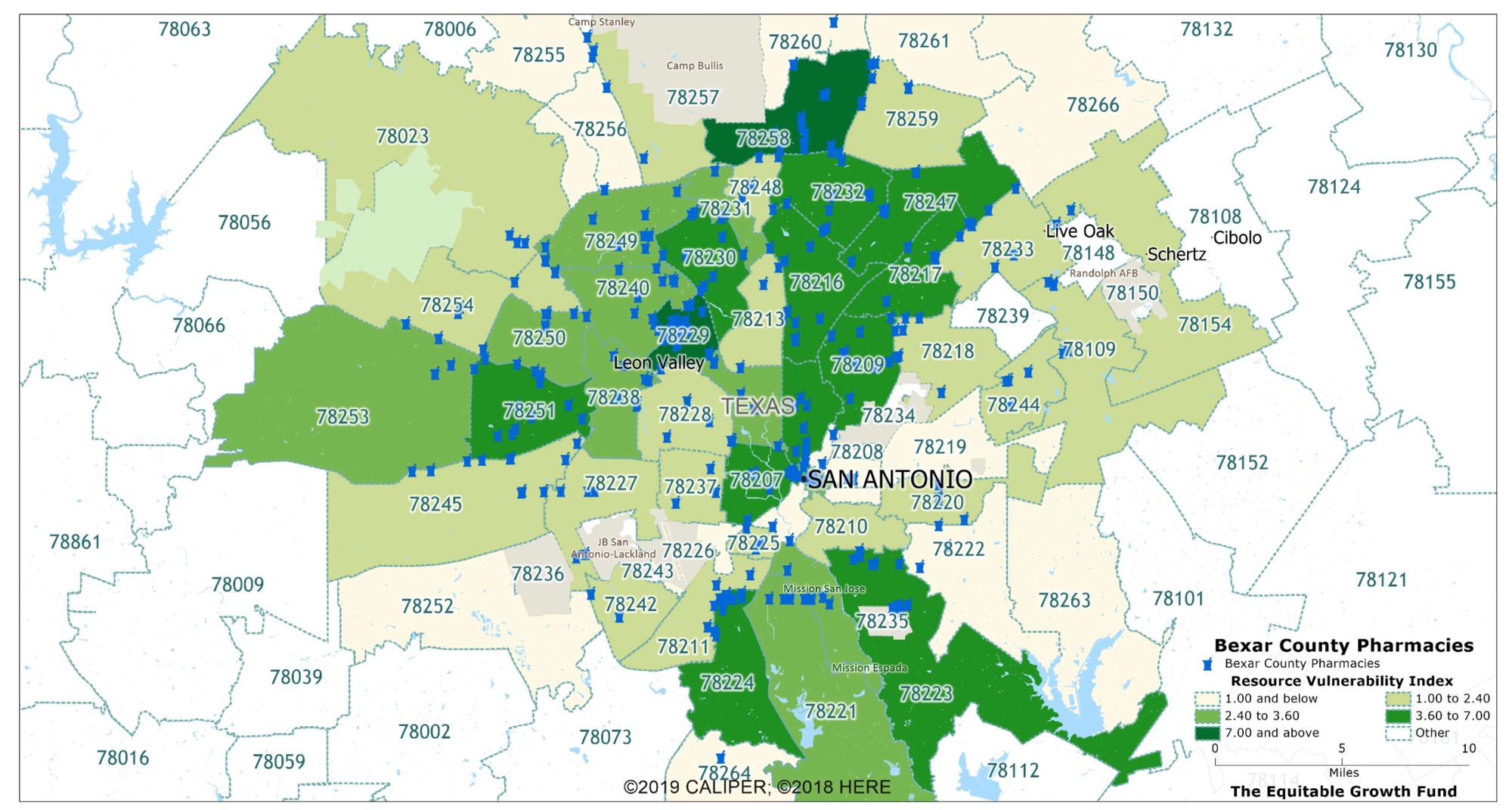
- High Pharmacy Concentration: In terms of pharmacies, 78229 is the most-served zip code, with 12 pharmacies reported. This suggests that residents in this area have better access to healthcare resources, possibly resulting in better health outcomes and increased convenience when obtaining necessary medications.
- Low Pharmacy Concentration: Conversely, numerous zip codes, including 78202, 78203, 78204, 78208, 78210, 78215, 78219, 78227, 78235, 78263, 78266, 78279, and 78288 reports no pharmacies. This lack of access can lead to significant health disparities, as individuals in these areas may face challenges in obtaining necessary medications, potentially leading to untreated or poorly managed health conditions.
Bexar County Grocery Store Analysis
Access to grocery stores is essential for maintaining a healthy diet, as they provide fresh produce, protein, and other nutritious food options.
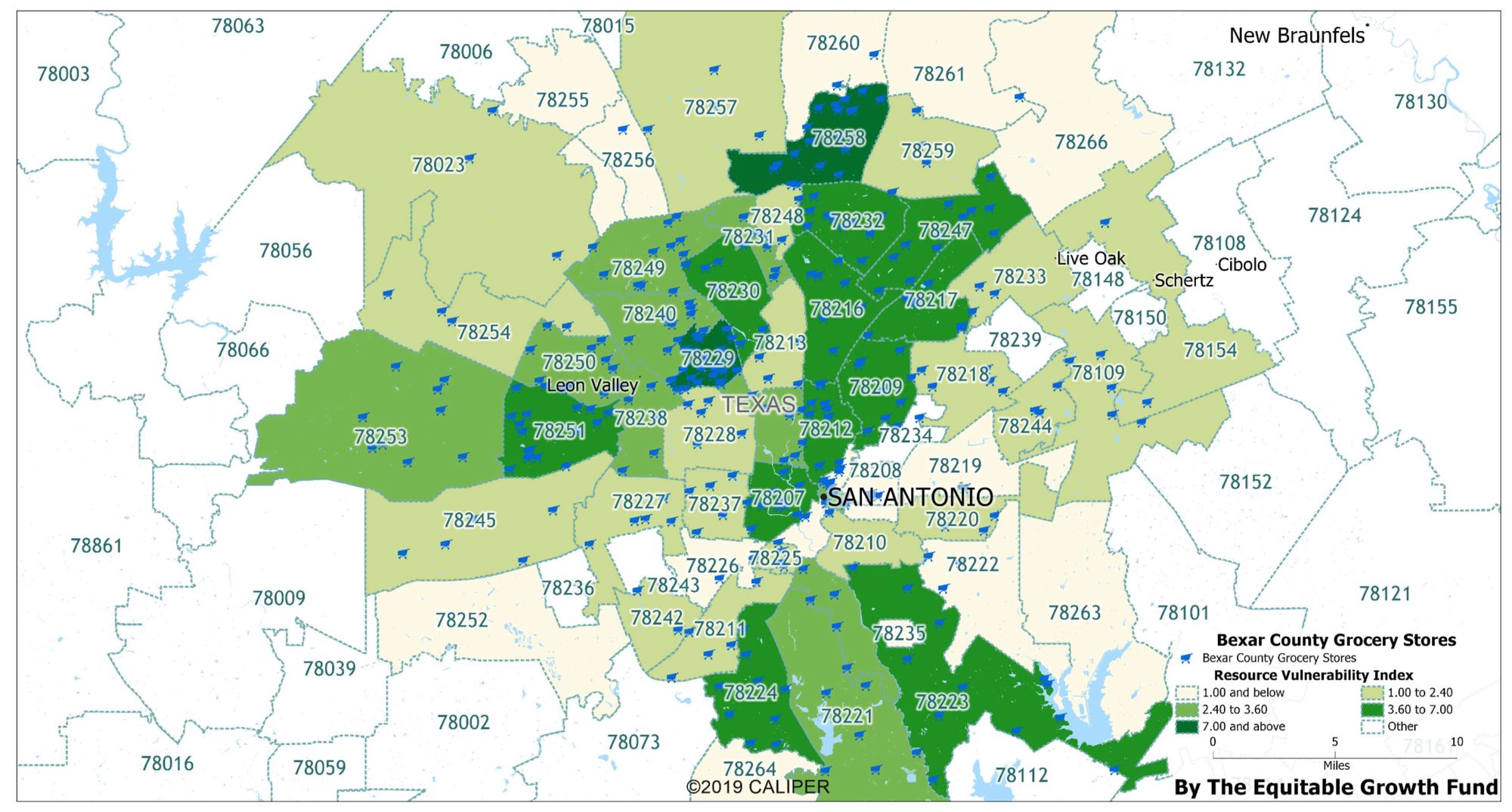
- High Grocery Store Concentration: 78229 and 78258 reports the highest number of grocery stores, each with 20. Residents in these areas likely have better access to fresh and healthy food options, which can contribute to better overall health and well-being.
- Low Grocery Store Concentration: On the other end of the spectrum, zip code 78235 reports no grocery stores, which can force residents to rely on convenience stores or fast-food restaurants that often lack fresh and nutritious food options. This can lead to poor dietary habits and associated health issues like obesity and heart disease.
Bexar County Hospital Analysis
Hospital accessibility is crucial to healthcare as hospitals provide various services, from emergency treatment to specialist care.
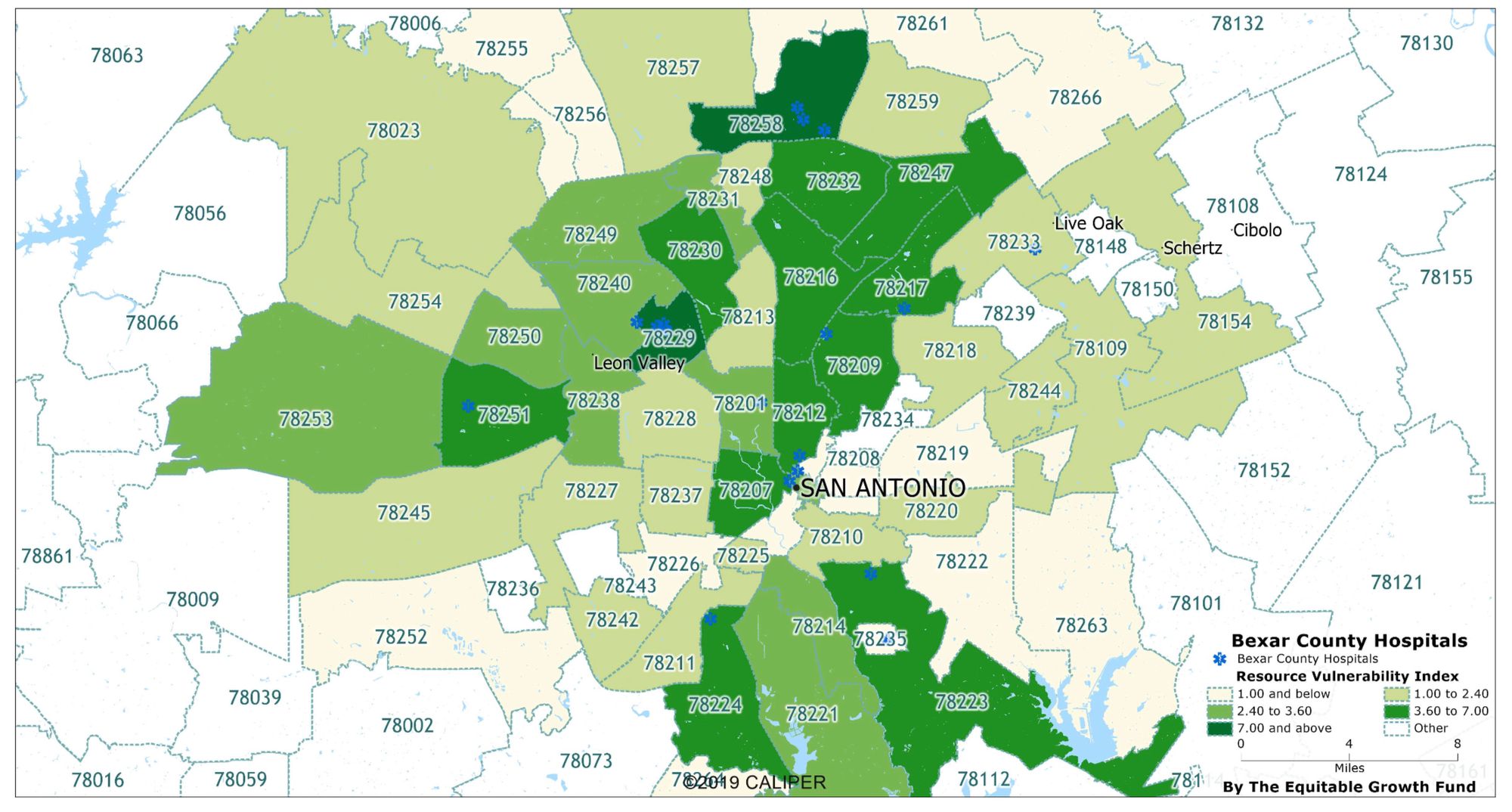
- High Hospital Concentration: Zip codes 78229 and 78258 are the only zip codes with more than one hospital, each having three. This suggests that residents in these areas have more options for care, including access to specialists and emergency services.
- Low Hospital Concentration: Alarmingly, most zip codes in Bexar County report no hospitals. This scarcity of hospitals can result in longer travel times during emergencies, delays in receiving care, and may discourage individuals from seeking routine and preventative healthcare services.
Bexar County Recreational Facility Analysis
Recreational facilities are important in promoting physical activity, fostering community interaction, and enhancing the quality of life.
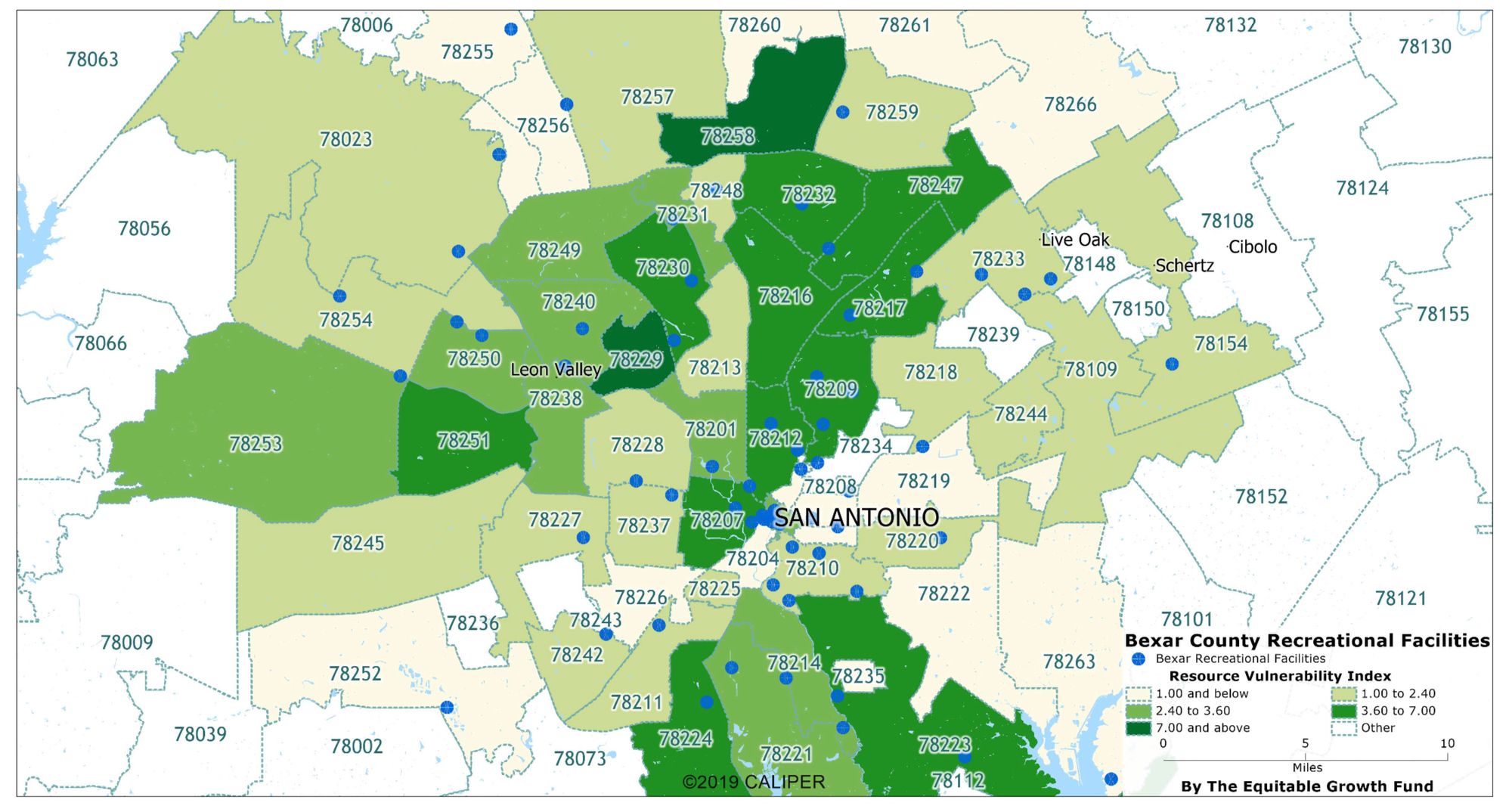
- High Recreational Facility Concentration: With five recreational facilities reported, 78209 offers the most opportunities for recreation. These facilities provide residents with spaces to exercise, participate in sports, and engage in other activities, which are crucial for physical and mental health.
- Low Recreational Facility Concentration: Many zip codes, including 78109, 78213, 78216, 78229, 78244, 78247, 78249, and 78251, report no recreational facilities. The lack of these resources can limit opportunities for physical activity, contributing to a sedentary lifestyle and associated health problems. It also deprives communities of shared spaces where social connections and a sense of community can be fostered.
Conclusion
The analysis shows a significant variation in resource availability across the Bexar County, TX, zip codes. The data highlights the need for more hospitals across almost all zip codes. Also, specific zip codes need a considerable increase in essential resources like banks, pharmacies, grocery stores, and recreational facilities to lower their resource vulnerability. The analysis and RVI will help guide the allocation of resources and inform strategies for improvement in the identified areas.
Please note: RVI is a dynamic index. It is subject to change with the availability of more recent data. It is also advisable to periodically update the weightage assigned to each category based on socioeconomic factors, and population needs changes.
